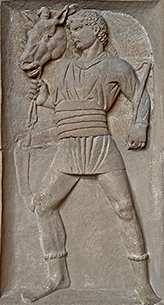

Chariot racing was the most popular sport in Rome, appealing to all social classes from slaves to the Emperor himself. This appeal was no doubt enhanced by the private betting that went on, although there was no public gambling on the races. Although most Roman charioteers (called aurigae or agitatores) began their careers as slaves, those who were successful soon accumulated enough money to buy their freedom. The four Roman racing companies or stables (factiones) were known by the racing colors worn by their charioteers (Red, White, Blue, and Green), and fans became fervently attached to one of the factions, proclaiming themselves “partisans of the Blue” in the same way as people today would be “Yankee fans.” The factions encouraged this sort of loyalty by establishing what we might call “clubhouses” in Rome and later in other cities of the empire.
The mosaic above shows a charioteer from each of the factions and illustrates the typical uniform of the charioteer, with a short decorated tunic in the color of the stable and leather strips around the chest, arms, and legs. Charioteers wore little body protection and only a light helmet; their practice of wrapping the reins tightly around their waists so they could use their body weight to control the horses was exceedingly dangerous in the case of accidents, since they could be dragged and trampled before they could cut themselves loose with the dagger that they always carried.

The four stables competed for the services of the best charioteers, whose popular celebrity surpassed even that of modern sports heroes, and they were depicted in many statues and monuments, like this relief from Neumagen, Germany. One famous charioteer of the second century CE, Gaius Appuleius Diocles, left a detailed record of his career (CIL 6.10048). He began driving for the Whites at the age of 18; after 6 years, he switched to the Greens for 3 years, and then drove 15 years for the Reds before retiring at the age of 42. He won 1,462 of the 4,257 four-horse races in which he competed, and his winnings totaled nearly 36 million sesterces. Diocles' career was unusually long; many charioteers died quite young (Fuscus at 24, Crescens at 22, Aurelius Mollicius at 20). In the Circus Bookshop, read the epitaph for the famous charioteer Scorpus written by the poet Martial and a tombstone inscription for the young charioteer Crescens.
Barbara F. McManus